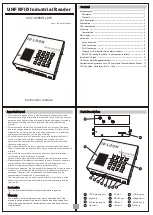
6
IM 04L57B01-02EN
Recommended positions
of the hooks
35
(1.38)
70(2.76)
17.9 (0.70)
44(1.73)
Hooked on a wall
At least 10 mm below the
neck of the screw
3.5~4.0mm(0.14 to 0.16)
wall
surface
Wall to
mount on
Wiring
● Applying a strong tension to the input signal cables
connected to the GX70SM may damage the cables or
the GX70SM terminals.
Make sure that pulling force is not directly applied to
the terminals of this product.
● To prevent fire, use signal cables with a temperature
rating of 70°C or more.
● Do not apply voltages that exceed the following val
-
ues to the input terminals. Doing so may damage the
instrument.
• Allowable input voltage:
±10 VDC for thermocouple, DC voltage (200 mV range
or lower), RTD, DI (contact input)
±30 VDC for voltage (2 V range or higher), DI (level)
● This instrument conforms to overvoltage category I,
Pollution degree 2, Measurement category O.
Precautions to Be Taken While Wiring
Take the following precautions when wiring the input signal
cables.
● We recommend the following wire.
Cross-sectional
area
0.08 mm
2
to 2.08 mm
2
(AWG28 to 14)
Stripped wire
length
5 to 6 mm
● Take measures to prevent noise from entering the
measurement circuit.
• Move the measurement circuit away from the power
cable (power circuit) and ground circuit.
• Ideally, the object being measured should not generate
noise. However, if this is unavoidable, isolate the
measurement circuit from the object.
Also, ground the object being measured.
• Shielded wires should be used to minimize the noise
caused by electrostatic induction. Connect the shield to the
ground terminal of the GX70SM as necessary (make sure
you are not grounding at two points).
• To minimize noise caused by electromagnetic induction,
twist the measurement circuit wires at short, equal
intervals.
• Make sure to earth ground the functional ground terminal
through minimum resistance.
● When using internal reference junction compensation on
the thermocouple input, take measures to stabilize the
temperature at the input terminal.
• Do not use thick wires which may cause large heat
dissipation (we recommend a cross sectional area of 0.5
mm
2
or less).
• Make sure that the ambient temperature remains
reasonably stable. Large temperature fluctuations can
occur if a nearby fan turns on or off.
● Connecting the input wires in parallel with other devices
can cause signal degradation, affecting all connected
devices. If you need to make a parallel connection, then
• Turn the burnout detection function off.
• Ground the instruments to the same point.
• Do not turn ON or OFF another instrument during
operation. This can have adverse effects on the other
instruments.
• RTDs cannot be wired in parallel.
Installing and Removing Batteries
1. Remove the battery case cover by sliding the cover while
pressing on the A in the following figure.
1
2
A
2. Insert two batteries (CR123A) into the battery case, or
remove them.
(Batteries are not included. Please obtain them
separately.)
* Pay attention to the polarities and static electricity when
inserting batteries.
* Electric double-layer capacitors are used in this
instrument.
When batteries are removed, the instrument
continues to operate until the energy charged in the
capacitors are used up.
3. Slide and attach the battery case cover.
Attaching and Detaching the Terminal
Block
The terminal block can be attached and detached. This
makes it easy to wire the terminal block.
1. Loosen the terminal block attachment screws.
2. Pull out the terminal block.
3. When you are attaching the terminal block, tighten the
attachment screws.
Recommended torque for tightening the terminal block
attachment screws: 0.1 N•m
Terminal block attachment screws


























